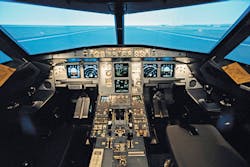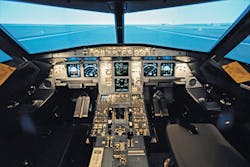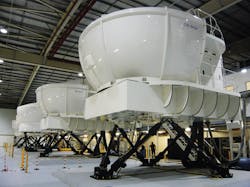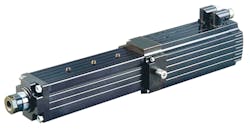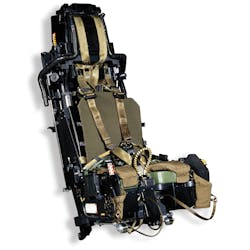Flight Simulators Go from Hydraulics to All-Electric
This file type includes high resolution graphics and schematics when applicable.
An ideal flight simulator replicates the 3D or spatial feel of flying while closely matching the real-world reactions of the pilot’s controls. So when pilots in the simulator activate the controls, they should experience the same response as when they are in the actual planes. Until recently, simulators relied on electrohydraulic actuators to provide feedback to pilots and power the simulator’s motion. Today, full-flight-simulator designers use the same mechanical concepts but the actuators are all-electric.
Electric actuators and components for simulators such as the Moog ball screw — which translates rotational motion into linear motion — are designed for longer life with less maintenance, and greater efficiency to provide the high levels of system availability the market requires.
Requirements
A key safety provision for flight simulators is preventing the cockpit/crew stations from dropping uncontrolled when there’s a loss of electric power or other fault conditions. Instead, the simulator should stop or gracefully return to its starting position to let the aircrew safely exit.
One option used to ensure the pilot or aircrew escapes the simulator in case of a fault is to equip the simulator with a backup battery capable of energizing the motor long enough to get the simulator to the home position. The return-to-home feature independently drives the actuator motor using batteries and a sensorless controller when servo power is unavailable. Simulators with a backup battery closely perform as the hydraulics did with an accumulator at each leg and an abort valve, which supplied pressure to the retract side of the cylinder and returned the simulator to its start position.
Hydraulics can typically handle a wide range of large loads with the same servovalve and actuator, while electric actuators have a more limited range. The challenge to engineers was replicating hydraulics’ payload-handling abilities with electrics. Developments in higher-power density devices have allowed engineers to use servodrive technology to match the performance of hydraulics. For example, engineers boosted the power density of brushless servomotors by using high-energy magnets. The advantage of these upgraded components is they draw less power than hydraulic alternatives while sacrificing none of the precision, speed, and availability.
Simulator operators also require high fidelity, or smooth motions with little noise to prevent. To meet these requirements, Moog upgraded ball-screw and servodrive technology, as well as software algorithms to minimize actuator noise.
This file type includes high resolution graphics and schematics when applicable.
Trends in simulator design
This file type includes high resolution graphics and schematics when applicable.
Engineers and pilots have always evaluated simulators subjectively. In the future, the flight simulation industry is apt to take a more deterministic, or objective, approach to evaluating simulators and take the subjectivity out of the validation process. The goal will be to provide the same performance across all simulators while making the qualification process more efficient.
How motion cueing is evaluated will be critical to achieving this goal. Motion cueing uses the pilots’ senses (sight, sound, and haptics) to make them believe they are moving, turning, and accelerating more than they actually are. For example, simulators recreate many of the effects of take-off and climb even though the simulator does not accelerate to 200 mph or ever climb higher than the stroke of the actuator.
By tuning a simulator to execute cueing algorithms that mimic sensations in actual flight, the industry will better prepare pilots to fly before they ever leave the ground.
The Moog G-seat
Motion simulators cannot recreate the sustained accelerations felt by fighter pilots. So for training, military-aircraft pilots strap into a Moog G-seat installed in the cockpit section of the simulator. The “cockpit” is wheeled into a spherical multiscreen display, much like a smaller version of an IMAX theater. While the cockpit does not move, the pilot’s controls (stick, throttle, and rudder) are hooked to the computer generating the graphics on the inside of the dome, which provides visual cues of the aircraft’s movements.
The motion or physical cues come from small electric actuators invisibly mounted in the seat bucket, seat pan, and back pad. These actuators push or pull on the pilot at up to 100 mm/sec for distances of up to ±25 mm, and recreate accelerations of up to 1,200 mm/sec2. The shoulder and lap belts are also hooked into tensioning mechanisms that add to the realism. For example on take-off, the seat back pushes out, and the lap and shoulder belts tighten, making pilots feel as if they are accelerating.
For more realism, harness and leg straps can be controlled and an additional actuator in the seat pan replicates rolling options. The G-seat can replicate positive and negative gs by changing the shape of the seat pan, raising or lowering the seat bucket, and altering tension on the harness. This closely recreates conditions pilots encounter in dogfights and bombing runs such as stall buffet and weapons release.
The seat looks like a standard ejection seat found in tactical military aircraft. But there is also a version specifically for simulating helicopter flight where vibrations from the blades are critical cues.
This file type includes high resolution graphics and schematics when applicable.
